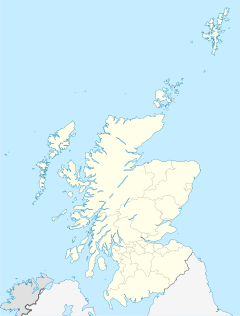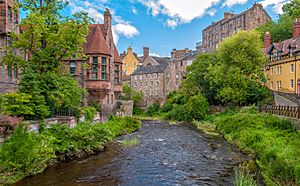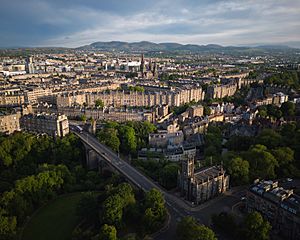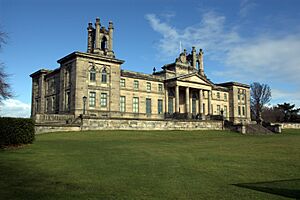Dean Village facts for kids
Quick facts for kids Dean Village |
|
|---|---|
| OS grid reference | NT 24103 74085 |
| Council area |
|
| Country | Scotland |
| Sovereign state | United Kingdom |
| Post town | Edinburgh |
| Postcode district | EH4 |
| Ambulance | Scottish |
| EU Parliament | Scotland |
| Scottish Parliament |
|
Dean Village is a charming old village located right next to the city center of Edinburgh, Scotland. Its name, "Dean," means "deep valley," which makes sense because it sits in a beautiful valley carved by the Water of Leith river. For over 800 years, this village was a busy place where people used the river's power to grind grain into flour. It was once known as the "Water of Leith Village" and had as many as eleven working mills!
Contents
A Look Back at Dean Village
How the Village Grew
Dean Village is one of the oldest settlements that grew up around the main city of Edinburgh. People called it the miller's village in 1535, and it even showed up on a map from 1560. Later, in 1585, official records called it "Water of Leith." The name 'Dean Village' first referred to a small group of homes higher up, near where the Dean Cemetery is now.
One of the earliest mentions of the "Dene" area was around 1145. This was when King David I gave one of his mills here to Holyrood Abbey.
Because so many mills were here, Dean Village became very important to Edinburgh's bakers. The bakers even built their meeting hall, called a 'Tolbooth', here around 1675.
The bridge over the Water of Leith, right in the middle of Dean Village, is thought to be a very old crossing point. The bridge you see today was built in the early 1700s. It was wide enough for a horse and carriage and was the main way to cross the river on the road from Edinburgh to Queensferry.
In 1609, Sir William Nisbet, who later became the Lord Provost of Edinburgh (like a mayor), bought the Dean area. He might have built or updated a large house there, which became known as Dean House. This house was a strong tower house from the 1500s or early 1600s.
Why the Mills Closed Down
Dean Village stayed a separate village until the 1800s. But then, bigger and more modern flour mills were built in Leith. This meant Dean Village's mills weren't needed as much, and business slowed down.
In 1826, John Learmonth, who would also become a Lord Provost, bought the Dean area. He wanted to expand Edinburgh's New Town further north.
To do this, a new bridge was needed to cross the deep valley, completely bypassing the old village below. The famous engineer Thomas Telford designed this bridge. It was built between 1831 and 1832 and opened in 1833. This new bridge allowed traffic to go right over Dean Village instead of through it.
The Dean Bridge has four arches and is over 400 feet wide. It stands 106 feet above the river! This bridge carries Queensferry Road over the Dean Gorge and the village. It made it much easier to travel west from Edinburgh and helped new parts of the city grow. In 1912, the sides of the bridge were made taller.
In 1847, the Dean Cemetery was created on the site of Dean House. The old mansion was taken down in 1845 to make way for the cemetery. Some carved stones from the house are now part of the cemetery's wall. Seven painted panels from the great hall of Dean House are now in the National Museum of Scotland. The cemetery is a special place where many famous people are buried, including the railway engineer Sir Thomas Bouch.
In 1887, another new bridge, called Belford Bridge, was built. This meant travelers could now mostly avoid the old Dean Village entirely.
As the city's West End grew, its buildings started to surround the old Dean Village. Large Victorian buildings were built right up to the Water of Leith. Two big Georgian buildings were also built nearby: the John Watson's School in 1825 and the Dean Orphanage in 1834.
For many years, Dean Village became a place of decay and poverty, reaching its lowest point around 1960.
A New Beginning for Dean Village
From the mid-1970s, people started to see Dean Village as a peaceful spot very close to the city center. Work began to fix up and restore the old workers' cottages, warehouses, and mill buildings. New homes were also built on former industrial sites.
Today, Dean Village is a very popular and beautiful place to live.
The Water of Leith Walkway, a path that runs from Balerno to Leith, was created through the area in 1983.
Dean Bridge has even appeared in books! It was featured in Ian Rankin's book Strip Jack and in the second book of the Peter May Lewis trilogy, The Lewis Man.
Gallery













